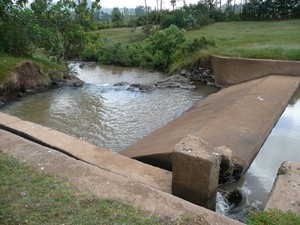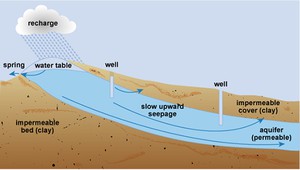Sources of water
Our main sources of water for drinking, washing, agriculture and industry are surface water, groundwater and collected rainwater, all of which are dependent on rain and snow falling on the Earth’s surface.
Surface water
Rivers, streams, lakes, and ponds are widely used as water sources in Ethiopia, especially in rural areas (Figure 4.5). The amount of available surface water depends largely on rainfall. When rainfall is limited, the supply of surface water will vary considerably between wet and dry seasons and also between years. One way to overcome this problem is to construct a dam across a river to create a reservoir that provides water storage. Large surface water reservoirs may be used for hydroelectric power generation, regulating water releases to control river flows, for recreational purposes and to provide water for agricultural, municipal and industrial uses. Smaller dams are also used to enable irrigation (Figure 4.6). The water collects behind the dam and flows under gravity into irrigation channels leading to the fields.

Figure 4.5 Many people rely on lakes and rivers for their water supply

Figure 4.6 Small dams hold back river water so it flows into irrigation channels.
Groundwater
An aquifer is an underground layer of water-bearing rock.Water-bearing rocks are permeable, meaning that liquids and gases can pass through them. Groundwater is the water contained in aquifers (Figure 4.7). This is replenished or recharged by precipitation that percolates through the soil to the water table, and by water seeping from streams, as well as other bodies of surface water, such as lakes and wetlands.

Figure 4.7 Groundwater formation.
The water table is the top of the groundwater below the land surface. Its level fluctuates seasonally and from year to year as the inputs from precipitation and the outputs vary. The depth of the water table also varies with location, from being near to the land surface in areas close to surface water bodies and in humid climates, to being hundreds of metres below the land surface in drier regions.
Groundwater reaches the surface naturally through springs or artificially through wells. Springs typically rise up where the water table meets the land surface. Springs are important sources of water to feed streams and are attractive cultural and landscape features in themselves. Wells and boreholes are dug by hand or drilled by machine. These have to be deep enough to extend below the water table so that water can be drawn up by bucket or by pumping.
Rainwater
Rainwater is also an important source of water, although on a relatively small scale. Collecting rain from roofs or other hard-surfaced areas and storing it until it is needed can provide a valuable source of water for many purposes.